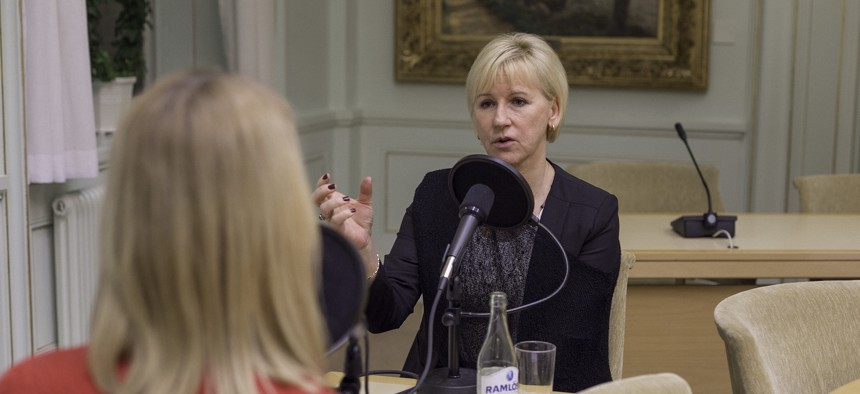
Sweden's Minister for Foreign Affairs and Deputy Prime Minister Margot Wallström conducts an interview in 2015. Victor Svedberg/Socialdemokraterna via Flickr
The Myth of the 'Female' Foreign Policy
As more women become heads of state, will the world actually change?
Margot Wallström took office as Sweden’s foreign minister in 2014, declaring she would pursue a “feminist foreign policy.” She’s now held the post for two years, and it’s still not entirely clear what she meant. While it’s true that an entire school of feminist international-relations theory has developed since the 1980s, the field remains contested, and largely untested in the realm of policy. You could surmise from Wallström’s term, as she herself stated, that a “feminist foreign policy” would promote women’s rights around the world, but what would it say, for example, about the logic of preventive war? Would it prioritize free trade and open borders, or emphasize protecting workers from competition? Would it generate a new way of dealing with unsecured nuclear material in the former Soviet Union?
Granted, Wallström has not had much time to implement the idea; relative to longstanding foreign-policy traditions like realism, feminist foreign policy hasn’t yet had a chance to leave much of a track record. So far, one of its key features has been controversy: The Swedish foreign minister’s first major move was to recognize Palestine, infuriating Israel; Saudi Arabia temporarily broke ties with her government over her vocal stance on human rights (she had declared the kingdom’s flogging of a blogger to be “medieval.”) She has spoken up for migrants and against rape as a weapon of war. And her ongoing experiment raises bigger questions about what it means for more women to conduct foreign policy, not just as ministers and diplomats, but as heads of state. In short, whether the foreign policy is explicitly feminist or not: Do countries behave differently when women are in charge?
Scholars as well as public figures have suggested that a world run by women would, fundamentally, be a more peaceful and equal one. We ladies, as the stereotype goes (and, actually, as a decent amount of empirical research suggests), tend to be more collaborative in work and leadership, more empathetic, and much, much less violent on an individual level than men. If, as Vice President Joe Biden recently suggested to my colleague Steve Clemons, “foreign policy is a logical extension of personal relationships,” and if women are widely acknowledged to be canny at conducting them, perhaps it follows that female leadership in international affairs would produce more empathy and collaboration between countries. To the extent that global problems like violence and inequality are actually failures of empathy, perhaps global gynecocracy produces a genuinely different, better world.
In the Dalai Lama’s somewhat simplistic summary of this kind of reasoning: “Females have more sensitivity about others’ wellbeing.” Or take the Stanford scholar Francis Fukuyama: “[S]tatistically speaking it is primarily men who enjoy the experience of aggression and the camaraderie it brings and who revel in the ritualization of war that is, as the anthropologist Robin Fox puts it, another way of understanding diplomacy. ... A truly matriarchal world, then, would be less prone to conflict and more conciliatory and cooperative than the one we inhabit now.” Or Harvard’s Steven Pinker, after observing how men have dominated armies throughout history: “Men can also boast about occupying the top slots in history’s long list of conquering maniacs, bloodthirsty tyrants, and genocidal thugs. ... Over the long sweep of history, women have been, and will be, a pacifying force.”
All good—and kind of flattering!—in theory. But do biological or psychological differences between men and women translate to differences in how women might run countries? One recent working paper, by Oeindrila Dube of University of Chicago and S.P. Harish of New York University, found that in Europe between the 15th and 20th centuries, queens were more likely to participate in interstate conflicts than kings were. In 20th-century electoral democracies, as Pinker and Fukuyama both noted, female leaders have indeed waged war. Indira Gandhi, Golda Meir, Margaret Thatcher, and Chandrika Kumaratunga may well have been personally compassionate, yet thousands of soldiers killed and were killed on their orders. In Hillary Clinton, the United States may get its first female president this year. But she was a champion of violent intervention in Libya as secretary of state; if she becomes president, there’s every reason to think she would continue, and perhaps escalate, America’s war on the Islamic State in Iraq and Syria.
Given the sparse and contradictory evidence, then, it’s difficult to say how countries led by women might behave differently than those led by men.
“The truth is, I don’t have an answer to that question,” said Farida Jalalzai, a political science professor at Oklahoma State who has studied women in political leadership. There simply haven’t been enough women leading states in the modern era to yield clear data on the question. Last year, the Pew Research Center noted that the number of female national leaders globally had doubled in the decade since 2005—to a whopping 18, meaning that less than 10 percent of UN member states are headed by women.
“You’re going to be able to cherry-pick either way,” Jalalzai said. “Even if we were to take a Margaret Thatcher, for example, we could say, ok, so she did go to war over the Falkland Islands. At the same time you could say, well, Ellen Johnson Sirleaf has kept Liberia peaceful,” when the country was formerly wracked by two civil wars spanning more than a decade. For that matter, where a female head of state’s term coincides with a period of peace, how much can be attributed to distinctly “feminine” leadership qualities, versus that particular woman’s partisan preferences, or even the conditions under which she rose to power? If the assumption that women are more peaceful makes voters consider them unqualified to lead in wartime, women would be more likely to get into leadership positions under peaceful conditions in the first place.
Most of the real foreign-policy effects of having women run countries, if indeed there are any, won’t really be known until more women do it. In the meantime, we can speculate about indirect benefits based on what we do know. For example, Valerie Hudson of Texas A&M University, along with her coauthors, has shown that “the best predictor of a state’s peacefulness is how its women are treated,” which could suggest that, to the extent women are more likely to prioritize the treatment of other women around the world (as both Wallström and Clinton have), they may also be contributing to peace. There’s also evidence that peace settlements women are involved in tend to be more durable. On the other hand, female leaders could just as easily have different foreign-policy priorities—like, say, European integration, or the migrant crisis, or green energy.
A telling moment came in the aftermath of the U.K.’s vote to leave the European Union, in the aftermath of which David Cameron lost his job as prime minister, replaced by Theresa May. There were the ritual Margaret Thatcher comparisons, as well as another ritual that may grow more common in the coming years: the celebration of a woman swooping in to clean up her male predecessor’s mess. But Jalazai wonders whether expectations like these may hurt women in the end. In the United States, for example, the Pew Research Center last year found that adult respondents, by a margin of 34 percent to 9 percent, thought female politicians were better than male ones at compromise; 34 percent thought women were more honest and ethical, versus 3 percent who thought men were.
Yet female leaders, like any leaders, will sometimes make rash decisions, sometimes lie, sometimes behave unethically. They’ll default on international loan payments like Argentina’s Cristina Fernandez de Kirchner, get ensnared in corruption investigations like Brazil’s Dilma Rousseff, or, like Australia’s Julia Gillard get ousted by their own parties. And their failures may be attributed less to the conditions they confronted than to the fact that it was a woman confronting them. “How are we expecting [women] to clean up problems that have existed for decades if not hundreds of years?” Jalalzai asked. “Is there this higher price that women may end up paying for not being able to transform societies overnight?”
Maybe, in the end, it’s best to see a woman's foreign policy as a sometimes-unpredictable product of whims, domestic pressures, geopolitics, economics, and numerous other forces—in other words, as a human being's foreign policy.







